By Daniel A. Brown
The Brotherhood of the Spirit (renamed Renaissance Community in
1974) was one of the largest and most enduring communes in the
Northeast and as such was a distinct link between the commune
movement of the 1960’s and the New Age consciousness happening
today. In existence from 1968 through 1988, its rise and fall
mirrored that of its charismatic and mercurial leader, Michael
Metelica. A factor that made the Brotherhood of the Spirit
unique is that it underwent several distinct identity changes
during its 20 year history.
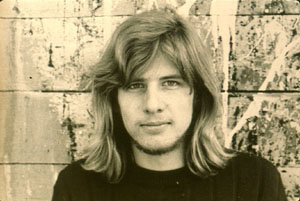
Michael Metelica, 1969
Michael Metelica was born in 1950 and grew up in the small rural
town of Leyden, Massachusetts. At age 16, he dropped out of high
school and, after reading an article about the Hell’s Angels
motorcycle gang, moved to California to join them. Repelled by
their violent nature, he was instead drawn to the 1967 hippie
Summer of Love, returning to Leyden the following year. In May
of 1968, he asked a local blueberry farmer named Donnie Herron
if he could build a treehouse on his land, and after receiving
permission, lived there in solitary meditation, working for
farmers for free and expecting nothing in return. Needless to
say, he became something of a local sensation and attracted his
first following from among his boyhood friends. After the
treehouse was destroyed in late 1968 by suspicious locals,
Metelica and his little band wandered around the many hill towns
in the area, gaining more members, teaching their view of
spirituality at area churches and schools until by early 1970,
they numbered around 50. Rules were mandated banning drugs,
cigarettes, alcohol and sexual promiscuity and members practiced
to purge themselves of their imperfections through meditation
and intense encounter-group confrontation tactics. By then,
Metelica knew that he had the makings of a deliberate community
that was based on spiritual beliefs and practice.
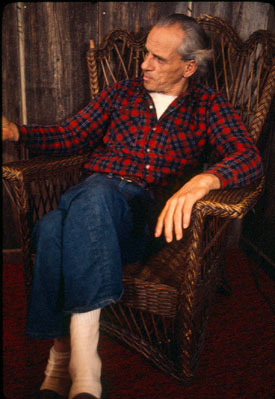 Elwood Babbitt, 1970 The
concept of spirituality was still new and uncharted in the late
1960’s but the group, now known as the Brotherhood of the
Spirit, had as its spiritual advisor, a local farmer named
Elwood Babbitt, a trance-medium in the Edgar Cayce tradition.
Both Babbitt and Metelica believed that the Earth was about to
undergo cataclysmic changes in preparation of the Aquarian Age.
Babbitt, in particular, was getting information through his
spirit guides who warned that humanity’s selfish and
self-destructive behavior would cause nature to literally rebel
in such a way as to cause widespread death and destruction
(while laughable when presented back in 1968, the current and
irrevocable crisis of global warming makes this theory a less
humorous matter). These “Earth Changes” as they were called
would be a precursor to the spiritual enlightenment of the
Aquarian Age, the next step in the evolution of the human race.
According to Babbitt, groups like the Brotherhood would be the
harbingers of this new age, functioning as teachers of this
higher wisdom to the shattered survivors of these worldwide
cataclysms.
Elwood Babbitt, 1970 The
concept of spirituality was still new and uncharted in the late
1960’s but the group, now known as the Brotherhood of the
Spirit, had as its spiritual advisor, a local farmer named
Elwood Babbitt, a trance-medium in the Edgar Cayce tradition.
Both Babbitt and Metelica believed that the Earth was about to
undergo cataclysmic changes in preparation of the Aquarian Age.
Babbitt, in particular, was getting information through his
spirit guides who warned that humanity’s selfish and
self-destructive behavior would cause nature to literally rebel
in such a way as to cause widespread death and destruction
(while laughable when presented back in 1968, the current and
irrevocable crisis of global warming makes this theory a less
humorous matter). These “Earth Changes” as they were called
would be a precursor to the spiritual enlightenment of the
Aquarian Age, the next step in the evolution of the human race.
According to Babbitt, groups like the Brotherhood would be the
harbingers of this new age, functioning as teachers of this
higher wisdom to the shattered survivors of these worldwide
cataclysms.
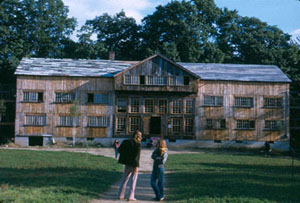 Warwick dorm, 1972 In March
of 1970, The Brotherhood purchased a 25-acre property in
Warwick, Mass., and the group underwent the first of its many
radical transformations. Their growth coincided with a
countercultural migration as millions of young Americans,
disenchanted with the “establishment” during the Vietnam War
era, dropped out of universities and cities en masse and hit the
road that summer looking for new venues. The membership
skyrocketed to 150 leading to the acquisition of an additional
house in nearby Northfield, the building of a dormitory in
Warwick and more stringent membership rules. Metelica became
less involved with the commune, devoting most of his energy to
the commune’s band “Spirit in Flesh” whose mission was to bring
about the message of spirituality through the medium of rock and
roll. In late 1970, Spirit in Flesh signed a contract with
Metromedia records and the commune’s focus began to shift into a
full-time promotion of the band.
Warwick dorm, 1972 In March
of 1970, The Brotherhood purchased a 25-acre property in
Warwick, Mass., and the group underwent the first of its many
radical transformations. Their growth coincided with a
countercultural migration as millions of young Americans,
disenchanted with the “establishment” during the Vietnam War
era, dropped out of universities and cities en masse and hit the
road that summer looking for new venues. The membership
skyrocketed to 150 leading to the acquisition of an additional
house in nearby Northfield, the building of a dormitory in
Warwick and more stringent membership rules. Metelica became
less involved with the commune, devoting most of his energy to
the commune’s band “Spirit in Flesh” whose mission was to bring
about the message of spirituality through the medium of rock and
roll. In late 1970, Spirit in Flesh signed a contract with
Metromedia records and the commune’s focus began to shift into a
full-time promotion of the band.
Veterans of the Brotherhood of the Spirit consider the
Warwick era as being the closest to their ideal of a spiritual
community composed of independently inspired individuals. Their
youthful enthusiasm allowed them to overcome the many hardships
created by an insulated environment dedicated to personal growth
and spiritual reflection. For the many that came from urban
backgrounds, Warwick introduced the realities of
self-sufficiency through logging, house building, the
cultivating and canning of homegrown food, and the ability to
enjoy life without the distractions of mainstream media. Their
spiritual belief system was based on aspects of Buddhism and New
Age thinking mixed with an enlightened, almost Gnostic form of
Christianity. Reincarnation, meditation, and the power of
positive thought were considered to be major doctrines.
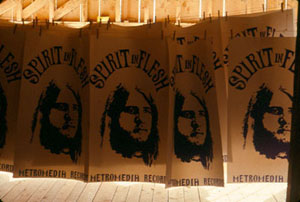 Spirit in Flesh posters The
years 1971-1972 were spent in frenzied activities surrounding
Spirit in Flesh, including the printing of several thousand
silk-screened posters that were placed all across the United
States and even into parts of Europe. Because of the sluggish
support from the record label, the commune devised its own
guerilla tactics to promote the band which included marches in
New York City, mass telephone call-ins to Metromedia, and
infiltrating popular national TV talk shows to announce the
band’s impending success. These tactics culminated in a concert
at Carnegie Hall that was sparely attended. The first album,
which featured the entire membership of the Brotherhood commune
on its cover, sold less than 1000 copies.
Spirit in Flesh posters The
years 1971-1972 were spent in frenzied activities surrounding
Spirit in Flesh, including the printing of several thousand
silk-screened posters that were placed all across the United
States and even into parts of Europe. Because of the sluggish
support from the record label, the commune devised its own
guerilla tactics to promote the band which included marches in
New York City, mass telephone call-ins to Metromedia, and
infiltrating popular national TV talk shows to announce the
band’s impending success. These tactics culminated in a concert
at Carnegie Hall that was sparely attended. The first album,
which featured the entire membership of the Brotherhood commune
on its cover, sold less than 1000 copies.
Despite the attention focused on Spirit in Flesh, the
Brotherhood had developed into an efficient entity which
contradicted the accepted stereotype of lazy commune hippies. An
elaborate infrastructure that included business management,
child care, auto maintenance, farming and food production had
been created to service the needs of its personnel. However, it
also created controversy due to its members being briefly on
welfare while Metelica was gifted with a Rolls-Royce. There were
also numerous run-ins with local selectmen about code violations
concerning the commune’s houses and septic systems. By late
1972, the membership had expanded to nearly 300. It was during
this time that the first public businesses were launched by the
commune along with a magazine, the Free Spirit Press, which was
sold along the East Coast from a rainbow-painted school bus. In
late 1972, the commune bought the Shea Theater block in Turners
Falls, a decaying working-class town next to Greenfield, and
made national headlines when Metelica issued an order to all
members to either work a job or leave. By now, the Brotherhood
of the Spirit had been featured in such media venues as the Wall
Street Journal; Look, Family Circle, and Mademoiselle magazines
as well as televised segments on 60 Minutes and the David Frost
show.
In 1973, the commune went through its most drastic and
traumatic change, morphing into what became known as the
Metelica Aquarian Concept. Metelica shifted his focus from his
band (renamed Metelica) to take absolute control over the
running of the commune. He demanded that every cent earned by
commune members be turned over to him whereby he then spent the
money to radically reshape the appearance of the group. A
shopping spree ensued that purchased 35 new cars (the tiny Honda
600 which got 50 mpg), three GMC motor homes and an airplane,
plus several movie, video and still cameras. Metelica’s aim was
to replace the image of ragged commune hippies with that of
media-savvy entrepreneurs who would change the mainstream
society by mimicking its need for image and materiality. This
shift in focus caused some long-term members to leave as well as
causing a more negative reaction from the local community.
Metelica’s demand for complete power caused a cult-like
mentality to permeate the group which was divided into a
distinct hierarchy with him as the unquestioned and undisputed
leader. The nadir of this period was the murder of commune
member Peter Luban while hitch-hiking from work, a crime which
was never solved and the subsequent “Metelica Marches” whereby
grim-faced members vigiled on the streets of Turners Falls and
Greenfield with signs proclaiming Metelica as a new religion.
The Shea Theater complex in Turners Falls became the nerve
center of the group while the Warwick property slowly fell into
decline. It was during this time that Metelica’s drug and
alcohol addiction began which would have dire consequences for
the group in the near future.
The following year, 1974, gave birth to the
legally-recognized and tax-exempt Renaissance Church and
Renaissance Community as Metelica changed his name to Rapunzel.
All community properties (which now included several residences
in Turners Falls) were outlandishly renovated while members
worked a variety of jobs in the outside world. The foremost of
these employers was at the Belchertown State School for the
developmentally challenged where 50 members worked on the wards
and earned a reputation for treating the residents there with
care and respect. The first of many business and creative
ventures were launched during this time while Rapunzel worked
full-time in the Shea Theater’s recording studio with various
bands. He also began a series of meetings for his followers
which were mainly lengthy monologues of his philosophy and
worldview. The Renaissance Church, meanwhile, opened its Sunday
services to the general public featuring music and meditations
with an accommodating spiritual philosophy. It also sponsored a
free Christmas dinner in the Shea Theater for the next few years
which was fully attended and highly popular with the outside
population.
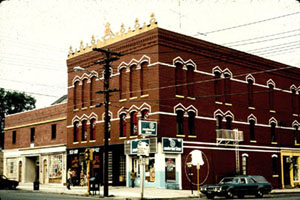 Shea Theater Block,
Shea Theater Block,
Turner's Falls, July 1973 1975 was the apex of the
Turners Falls era with Renaissance operating a dozen businesses
downtown including a 24-hour grocery, a record store, an audio
supply center and a stylized pizza parlor. Notable among these
were the Noble Feast restaurant which featured diversely
innovative cuisine, Rocket’s Silver Train which provided
luxury-modeled tour buses to rock musicians (Elvis Costello,
Pink Floyd, Linda Ronstadt, and Queen among others) and the
forerunners of the now nationally distributed Silver Screen
Design and Renaissance Greeting Cards. These were coupled with
contracting crews specializing in high-level industrial
painting, paving and excavating, carpentry and plumbing. There
was also an explosion of creative talent from community members
as the recording studio, video lab, darkroom and media equipment
were made freely available. The Choir, an all-women chorus, was
created at this time and performed both at church services and
at outside gigs. The community also produced the weekly
Renaissance Radio Show that attained national distribution and
featured topics ranging from the spiritual to the practical.
Outreach to the local community was made through a series of
free public events culminating in the Renaissance Faire, a
street festival that attracted about 3,000. The young people of
Turners Falls flocked to the community in droves, working in the
many new businesses or hanging out in the drop-in center members
created. It is worth noting that this Renaissance-inspired
revitalization of Turners Falls occurred without any government
grants or taxpayers’ money. The community at this point was
operating several dozen businesses and was, essentially,
self-supporting. Internally, the cult-like adoration of Rapunzel
slowly gave way to a growing sense of personal autonomy as
members practiced a variety of new skills and acquired
leadership abilities of their own.
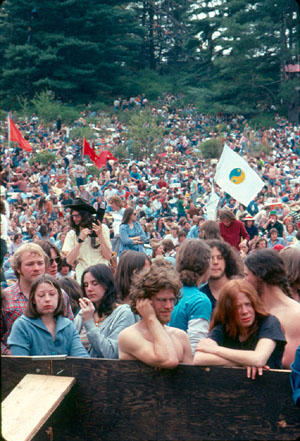 May Day Concert, 1976 At the
end of 1975, the Renaissance Community purchased the rural Olde
Stone Lodge in Gill and within a year decided to build a
self-sufficient community utilizing a variety of alternative
energy and sustainable technologies. Again, the group radically
changed its identity as the focus shifted away from the Turners
Falls businesses (which receded in number) to the building of
several innovatively-designed houses on the 80-acre Gill
property, nicknamed the 2001 Center. During this time, the
community began networking with other spiritual communities;
especially Findhorn in Scotland, whose leaders and members
exchanged visits with those of Renaissance. There was also a
huge increase of children who, coupled with the work on the
land, mellowed the community and led to its most relaxed and
harmonious years since its inception both within and without.
Despite a shaky start, due to the 1976 May Day rock concert in
which 14,000 people descended on this tiny town, the community
got along well with the citizens of Gill, a condition that
exists to the present. This apparent harmony, however, hid some
long-term resentment concerning Rapunzel’s omnipotent leadership
which came to the fore in late 1980. Leading the challenge were
the personnel of the greeting card company whose executives
doubled as Renaissance’s financial managers. Rapunzel’s skimming
of money from the community to satiate his uncontrollable
substance abuses was a major (if unspoken) concern as were
issues concerning safety and the screening of new members. The
dispute divided the community into two hostile groups
culminating in the decision by the card company to separate from
the community and re-establish itself in southern Maine. In all,
a large segment of core members departed, signaling the final
era of decline. Added to a small but steady migration that
occurred during the Turners Falls era, the population of the
community was drastically reduced to about 70 adult members with
an equal number of children.
May Day Concert, 1976 At the
end of 1975, the Renaissance Community purchased the rural Olde
Stone Lodge in Gill and within a year decided to build a
self-sufficient community utilizing a variety of alternative
energy and sustainable technologies. Again, the group radically
changed its identity as the focus shifted away from the Turners
Falls businesses (which receded in number) to the building of
several innovatively-designed houses on the 80-acre Gill
property, nicknamed the 2001 Center. During this time, the
community began networking with other spiritual communities;
especially Findhorn in Scotland, whose leaders and members
exchanged visits with those of Renaissance. There was also a
huge increase of children who, coupled with the work on the
land, mellowed the community and led to its most relaxed and
harmonious years since its inception both within and without.
Despite a shaky start, due to the 1976 May Day rock concert in
which 14,000 people descended on this tiny town, the community
got along well with the citizens of Gill, a condition that
exists to the present. This apparent harmony, however, hid some
long-term resentment concerning Rapunzel’s omnipotent leadership
which came to the fore in late 1980. Leading the challenge were
the personnel of the greeting card company whose executives
doubled as Renaissance’s financial managers. Rapunzel’s skimming
of money from the community to satiate his uncontrollable
substance abuses was a major (if unspoken) concern as were
issues concerning safety and the screening of new members. The
dispute divided the community into two hostile groups
culminating in the decision by the card company to separate from
the community and re-establish itself in southern Maine. In all,
a large segment of core members departed, signaling the final
era of decline. Added to a small but steady migration that
occurred during the Turners Falls era, the population of the
community was drastically reduced to about 70 adult members with
an equal number of children.
For the next few years, this remnant continued to build their
houses and maintain the land in Gill despite the departure of
other long-term members and the influx of new ones, some of whom
were violent or otherwise dysfunctional. Rapunzel’s increasingly
erratic behavior caused another rebellion against his authority
in 1984, this time centered around the silkscreen company. This
led to a final migration of vital members from which Renaissance
never recovered.
Meanwhile, reunions and newsletters of former members
signaled a shift in focus toward those who had left and were
trying to process the communal experience for themselves. From
1984 until 1988, the community, now down to its final dozen
members, struggled to maintain some semblance of cohesion as
group meetings and projects come to an end and the land itself
began to deteriorate. Rapunzel, meanwhile, “managed” the
community’s once-successful bus touring company into bankruptcy
as his abusive conduct became obvious even to his closest
friends. In 1988, the remaining community leadership offered him
$10,000 to leave and never return. He accepted and was never
seen on the Gill property again.
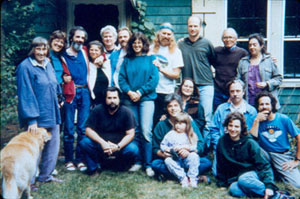
Gathering at Beth Hapdgood's, 1999
In 1988, the Renaissance Community as a recognizable
communal entity came to an end. The Gill property was cleaned up
and cooperatively managed. The various houses were sold off to
private ownership and the Olde Stone Lodge house was renovated
into separate apartments. Several successful contracting
businesses based in Gill still exist and there continue to be
regular seminars dealing with meditation and spiritual practice.
There have also been many well-attended reunions and gatherings
of former and current members where the issue of the community’s
controversial legacy remains a major topic. Those who were part
of the Brotherhood of the Spirit have gone on to become
teachers, artists, health-care providers, millionaire
executives, and at least one ordained Buddhist monk. Their views
about their time spent in the community run the full gamut of
human emotions and opinions. In May of 2006, a documentary film
about the community entitled “Free Spirits” was released, being
produced by a former member who teaches film at the University
of Massachusetts.
Michael Metelica Rapunzel lived out the remainder of his life
in the Hudson River valley in upstate New York. There he was
licensed as an EMT, attended AA to treat his addictions but was
diagnosed with terminal colon cancer in May of 2002. The
following month, a gathering in his honor occurred at the home
of his long-time friend and mentor, Beth Hapgood, which was
attended by his children and about 100 of his former followers.
He died in February of 2003.
Daniel A. Brown is a
writer, photographer and lecturer
who lived at the Renaissance Community from 1970-1984.
He can be contacted at
dbrown1793@rcn.com.